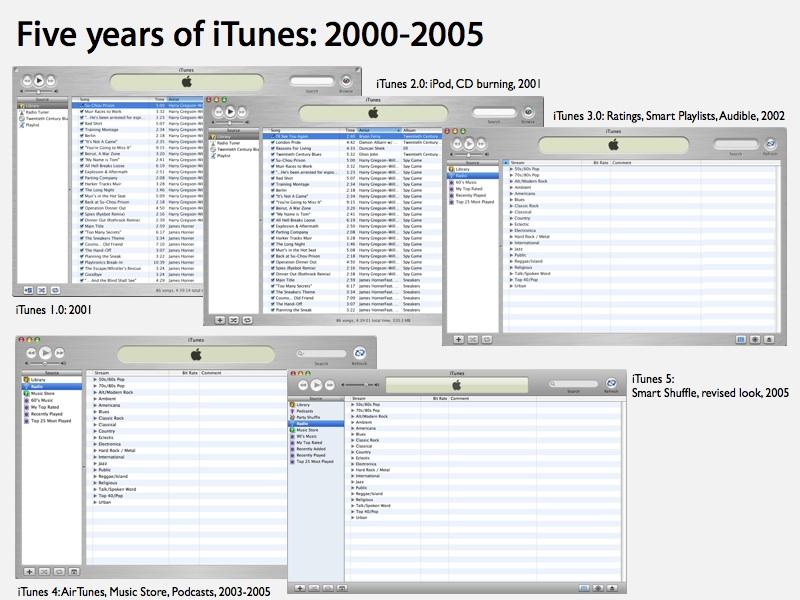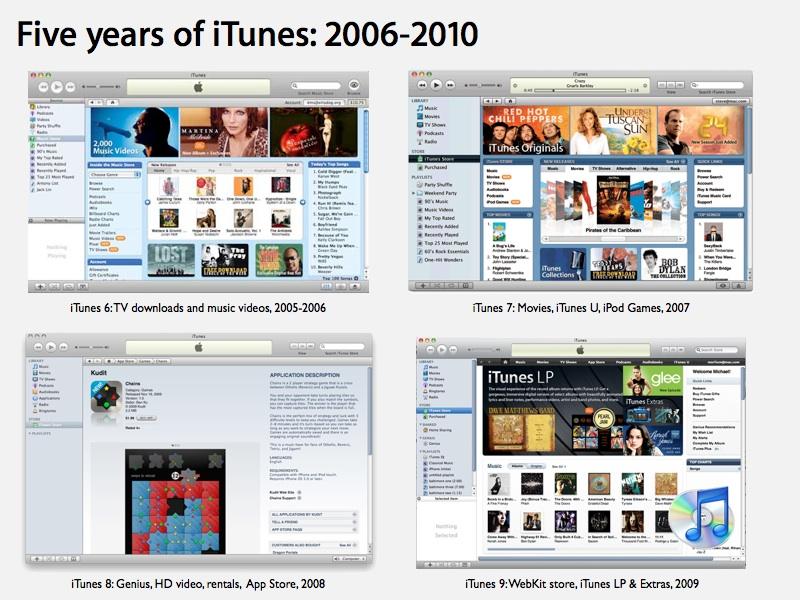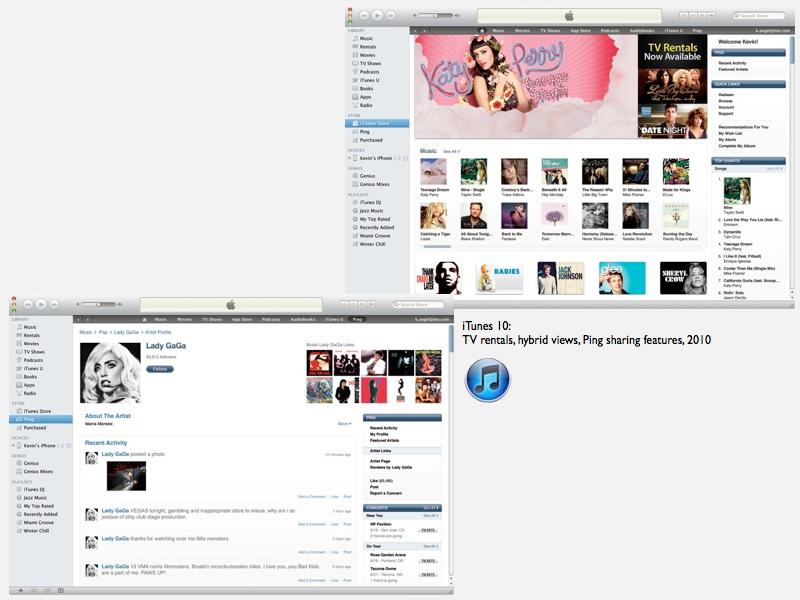Five years ago, Apple had just released the 5th generation iPod, the first capable of playing full motion video. It was offered in 30 and 60GB versions, costing $299 and $399.
The 30GB model boasted 14 hours of audio playback or 2 hours of video. Apple had just lined up the ability to buy TV shows in iTunes, starting with one broadcast partner: Disney. Episodes cost $2 and delivered half-VGA resolution of 320x240, which filled the iPod's 2.5" screen. Apple had also recently added support for Podcasts within iTunes.
Fast forward to today, and Apple's latest media player offering is the iPod touch. It similarly comes in 32 and 64GB versions at the same $299 and $399 prices. The difference is that these devices aren't slow hard drives; they're full screen computers with fast flash memory. There's also an 8GB version for $229.
The 32GB model delivers 40 hours of audio playback, or 7 hours of video. Apple's iTunes now offers full movies and rentals at VGA resolution of 640x480.
The iPod touch screen is not only larger, at 3.5 inches, but now delivers a Retina Display resolution of 960x640. It's also a capacitance touch screen that can be used to navigate the interface directly, rather than using a touch-wheel controller.
iPod is the computer
Originally conceived as a pod that could take music to go, Apple's iPod is now a full featured computer itself. It runs a scaled down version of Mac OS X named iOS, offering not just media playback but also email, web browsing, and the ability to run custom apps.
iTunes has transformed from a music store with some videos for sale into being the world's most popular way to buy music and movies, as well as the world's largest and most popular mobile apps market. There are over 300,000 apps available for the iPod touch, ranging from games to art tools to GPS to productivity apps.
The iPod touch isn't just more powerful, it's also smaller. Five years ago, the iPod was .43 to .55 inches thick and weighed 4.8 to 5.5 ounces. Today's iPod touch is roughly the same size, but only .28 inches thick and weighs just 3.56 ounces.
There's a lot more inside however. And a lot less; there's no mechanical hard drive to wear out, for example. The iPod touch can record voice memos via a mic-integrated set of headphones or its built in mic. It also has a 720p HD video camera that takes good point-and-shoot photos. It supports Apple's new FaceTime video conferencing, with both front facing VGA and rear camera support, as well as third party VoIP with video apps such as Fring and Skype. It also includes Bluetooth and WiFi wireless networking.
iPod for play and work
As a mobile gaming machine, the latest iPod touch provides six axis motion control with its accelerometer and gyroscope. It offers four times the screen resolution of Sony's PlayStation Portable and a far better display than Nintendo's DS. More importunely, the iOS library of games range from free to a few bucks, compared to the relatively expensive mobile games on dedicated players that can really only play games.
In addition to being a mobile games machine capable of causing anguish at Nintendo and Sony, the iPod touch has also turned into a serious business tool. Apple began using the device to replace mobile terminals in its retail stores last year, and other retailers are also building mobile point of sale programs around it.
Corporate, government and military programs have also adopted Apple's iPod touch, with third parties giving it the capability to do everything from monitoring equipment to editing documents to performing field training and foreign translation. Apple itself has turned the iPod into an enterprise friendly device in partnerships with Microsoft (to deliver secure push messaging for Exchange Server), Unisys (to deliver security apps for business customers) and others, customizing the iOS platform to support corporate proxy servers and VPNs from a variety of vendors.
On page 2 of 3: Riding iTunes.
In addition to hardware and software platform advances, Apple's iPod has benefitted from the constant refinement of iTunes, along with an expanding ecosystem of content Apple has created to add value to its mobile devices. Apple's pace of development with iTunes has particularly accelerated in the past five years.
In 2005, iTunes had just added support for free Podcasts (which now number over 150,000) and enabled support for iPod video in the short lived iTunes 5.0 and new 6.0 releases. The following year, Apple added Nike+iPod support, followed by iTunes 7.0, which introduced Cover Flow and new iPod games, a harbinger of iPhone apps. Apple also expanded its TV show business and began selling movies from Disney, while boosting the quality of videos it sold.
By 2007, there were over 500 feature length films available. Apple also launched iTunes U, which enables educational organizations to publish free podcast content. There are now over 800 institutions that have served 300 million downloads from iTunes U. Apple also introduced iTunes Plus DRM-free music at a higher bit-rate, and support for synching and managing content on the new iPhone and iPod touch.
In 2008, Apple added support for movie rentals after working out agreements with the studios, as well as support for its own new mobile apps in the iTunes App Store. The company subsequently released iTunes 8, with Genius Sidebars and Playlists for recommending music, and support for new 720p HD resolution video downloads and movie rentals.
In 2009, iTunes 9 was released with a new WebKit-based iTunes Store. Apple also introduced iTunes LP and Extras, along with a new Home Sharing feature for local media library sync. In 2010, Apple added support for its new iBooks digital book store, followed by the release of iTunes 10, with new AirPlay features and the Ping social network for recommending songs and following friends. The new version also got a new icon reflecting the iOS rather than a Compact Disc.
On page 3 of 3: Apple's style of innovation, Differentiating the iPad.
Since 2001, Apple's iPod designs has been closely copied, but no manufacturer has been able to slow the company's growth. The iPod originally emerged as Sony was selling its disc-based products and Microsoft was pushing its PlaysForSure reference designs for media players and digital download stores.
Apple surprised the market by maintaining a relentless pace of innovation that captured the initial market for hard-drive based MP3 players, then successfully began to take over flash RAM players with the 2005 iPod nano and low cost iPod shuffle. Former heavyweights from Sony and Microsoft to Creative, SanDisk, Toshiba, Samsung, Panasonic, iRiver and Archos were all left fighting over the remaining scraps.
Over the last five years however, Apple has executed an apparently flawless strategy for building its media player into a mobile computing empire. In 2007, the company released the iPhone, creating a hybrid of its desktop computing platform with the iPod's mobile portability and releasing it as a mobile phone in a very crowded and completive market.
That fall, Apple released the iPod touch as essentially the iPhone without a phone, but differentiated by an inability to use all of the same built in apps that the iPhone provided. Within months, the company release its first Software Development Kit for native iPhone apps, which also worked on the iPod touch. Apple also relaxed its product boundaries to allow the iPod touch to do nearly everything the iPhone could.
After the initial launch of the iPhone App Store in 2008, Apple singlehandedly created the first sustainable, popular market for mobile devices to be adopted by the mass market, leveraging the familiarity of iTunes.
Over the last two years, Apple has dramatically improved the iPod touch, applying both lessons learned from the iPhone as a software platform and manufacturing prowess resulting from the vast economies of scale provided by the iPod family. The company's mobile innovations have spilled over into Apple's notebook line of computers, while also benefitting from the mature development frameworks that originated on the Mac desktop.
Differentiating the iPad
The iPod touch is not just the company's flagship iPod, but is also a strong pillar supporting the iOS platform. Prior to having contracts in place with mobile providers in a variety of countries, Apple sold the iPod touch through carriers who bundled it with simpler phones. Apple continues to sell the iPod touch in large volumes, creating a volume of iOS devices that supports sales of iOS apps, in particular games.
The iPod touch also helped launch this year's iPad, enabling Apple to position the iPad as not merely a big iPhone, but as a different device category with its own apps optimized for a much larger display. While competing tablets are essentially a big iPod touch running Android (Samsung's Galaxy Tab, Dell's Streak), Apple's iPad offers a true tablet form factor, leaving the iPod touch to serve as the company's well differentiated mobile mini-tablet.
Other attempts to create an iPod touch competitor, ranging from Microsoft's Zune HD to Nokia's Nx00 Internet Tablet devices, haven't taken off in large part because they don't fit into an existing mobile strategy; the Zune was incompatible with both Windows Mobile 6 phones and the new crop of Windows Phone 7 models, while Nokia's mini-tablets run a desktop Linux rather than Symbian or anything recognizable to the company's huge audience of simple feature-phone users.
The only company with announced plans to copy the iPod touch is Samsung, which has announced plans to float a new Galaxy Player as the phone-free version of its popular Galaxy S smartphone running Android. However, Samsung's commitment to Android is being hedged by announcements of new devices running both Windows Phone 7 and Samsung's own Bada platform, which was launched this summer to sales numbers and an app library similar to Microsoft's WP7.
See also the AppleInsider feature: Five years of Apple: 2005 iBook to 2010 MacBook Air
 Daniel Eran Dilger
Daniel Eran Dilger










-m.jpg)






 Malcolm Owen
Malcolm Owen
 William Gallagher
William Gallagher
 Thomas Sibilly
Thomas Sibilly
 Wesley Hilliard
Wesley Hilliard
 Marko Zivkovic
Marko Zivkovic












19 Comments
Just a quick comment...when I bought my first nano, so thin....I thought it was the most "beautiful" piece of engineering I'd ever seen!
Same when I had bought the original shuffle a few months before....I was amazed.
Now 3 iPhones later...I love my iPhone 4 b/c it has the iPod "included" along with a decent still/video camera with flash, no less. So now I don't have to remember/forget my digital camera. Or buy a Flip.
Also, I've put in the Nike/GPS which means I don't have to use the "shoe accessory" anymore for my runs.
I've installed TomTom..which I really recommend highly. So I don't have to have a stand-alone GPS unit with an annoying clunky, subpar interface.
I sold my Mophie Juice Pack (for my 3Gs) b/c the 4 now has 40% more battery life. And I really notice it, too!
Anyway...best and Happy New Year!
PS. MOST DISAPPOINTING APP: Tetris...talk about not taking advantage of the Retina Display with its muted colors and it should be the whole screen too...I was more impressed with my Atari Centipede in 1985! Uggh!
Good piece AI. Makes me wonder how we all managed before the i stuff happened.
Happy New Year.
Didn't the iPod come out in 2001? It took 9 years to get to where we are today, not 5.
Yes, it did surface in 2001 but the article is focusing on the years 2005-2010, which is I suppose the years which have seen the resurgence of Apple, on the back of the i devices.
And the critics of Apple, especially the techtards, still don't get it... its the hardware, software and Apple's focus on a superior user experience based on ease of use, functionality and performance WHEN ITS READY (cut and paste, multitasking, battery life). And equally important to all of these, its the whole ecosystem which competitors simply can't match. Competitors will always be playing catch up with their inferior efforts.